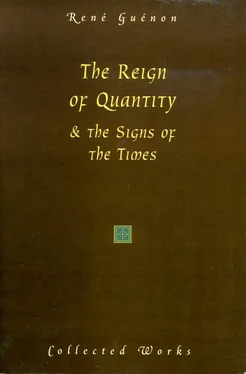Here this already long discussion must be brought to a close; it has amply sufficed to indicate in a general way the nature of the many ‘pseudo-initiatic’ counterfeits of the traditional idea that are so characteristic of our times: a mixture, more or less coherent but rather less than more so, of elements partly borrowed and partly invented, the whole dominated by anti-traditional conceptions such as are peculiar to the modern spirit, and for this reason serving no purpose other than the further spread of these same conceptions by making them pass with some people as traditional, not to mention the manifest deceit that consists in giving, in place of ‘initiation’, not only something purely profane in itself, but also something that makes for ‘profanation’. Should anyone now put forward the suggestion, as a sort of extenuating circumstance, that there are always in these affairs, despite all their faults, some elements derived from genuinely traditional sources, the answer would be this: in order to get itself accepted, every imitation must take on at least some of the features of the thing imitated, but that is just what makes it so dangerous; is not the cleverest lie, as well as the most deadly, precisely the lie that mixes most inextricably the true and the false, thus contriving to press the true into service in order to promote the triumph of the false?
37
The Deceptiveness of ‘Prophecies’
The mixture of truth and falsehood met with in the ‘pseudo-traditions’ of modern manufacture is found again in the so-called ‘prophecies’ that have been propagated and exploited in every way, especially in the last few years, for ends of which the least that can be said is that they are highly enigmatic. They are described as ‘so-called’ prophecies because the word ‘prophecy’ can only be properly used of the announcements of future events contained in the sacred books of the various traditions and proceeding from an inspiration of a purely spiritual order; any other use of the word is entirely misleading, ‘prediction’ being the proper word to use in all other cases. Predictions may come from quite varied sources; at least some have been a result of the application of certain secondary traditional sciences, and these are certainly the most valid, but only on condition that their meaning can really be understood, and this is not always very easy, because for many reasons they are usually formulated in rather obscure terms, which often do not become clear until after the events to which they relate have taken place; it is therefore always as well to be mistrustful, not of the predictions themselves, but of the erroneous or ‘tendentious’ interpretations that may be made of them. As for the rest, insofar as there is anything authentic in them, it emanates almost exclusively from ‘seers’ — sincere no doubt, though only very partially ‘enlightened’ — who have experienced certain confused perceptions related more or less accurately to a future that is usually not at all clearly determined, particularly as to the date and the order of succession of events, and who have unconsciously mixed those perceptions with their own ideas and consequently expressed them still more confusedly, so much so that it becomes possible to find in their statements almost anything one wants to find.
It is easy to see what purpose this sort of thing can serve under present conditions: such predictions almost always present everything in a distressing or even in a terrifying light, because that is the aspect of events that has naturally struck the ‘seers’, it is therefore enough, in order to disturb the mentality of the public, merely to spread them about, accompanied if necessary by commentaries that will emphasize their threatening aspect and will treat the events they are concerned with as imminent. [148] The announcement of the destruction of Paris by fire, for example, has been promulgated several times in this way, the exact dates being specified, although nothing has ever happened, except for the impression of terror invariably aroused in many people, and never growing any less with the repeated failure of the predictions.
If one prediction agrees with another their effect will be reinforced, and if they contradict one another, as often happens, they will only produce all the more disorder; in either case there will be so much the more gained by the forces of subversion. It must be added too that all these things, proceeding as they generally do from fairly low regions in the psychic domain, carry with them for that reason unbalancing and dissolving influences that add considerably to their danger, this no doubt being why even those who put no faith in them experience, in many cases, a kind of discomfort in their presence, comparable to that induced even in people who are not at all ‘sensitive’ by the presence of subtle forces of an inferior order. One would scarcely believe, for example, how many people have become seriously and perhaps irremediably unbalanced through the numerous predictions connected with the ‘Great Pope’ or the ‘Grand Monarch’. These predictions do contain a few traces of certain truths, but strangely distorted by the ‘mirrors’ of an inferior psychism, and in addition brought down to the measure of the mentality of the ‘seers’ who have to some extent ‘materialized’ them and have ‘localized’ them more or less narrowly so as to force them into the framework of their own preconceived ideas. [149] The relatively valid part of the predictions in question seems to be related chiefly to the function of the Mahdi and that of the tenth Avatāra ; these matters, which directly concern the preparation for the final ‘rectification’, are outside the subject of this book; all that need be mentioned now is that their very deformation lends itself to an ‘inverted’ exploitation leading toward subversion.
The way in which this group of predictions is presented by the ‘seers’ in question, who are very often the subjects of ‘suggestions’, [150] It must be clearly understood that this in no way means that they are the subjects of ‘hallucinations’: the difference between the meaning of the two terms is the difference between seeing things that have been consciously and voluntarily imagined by others, and imagining them oneself ‘subconsciously’.
makes a near approach to certain very dark and ‘underground’ matters, the astonishing ramifications of which, at least since the beginning of the nineteenth century, would be particularly interesting to follow for anyone who wanted to write a history of those times, a history would certainly be very different from the one that is taught ‘officially’. But needless to say there can be no question of going into the detail of these matters, and it must suffice simply to have mentioned this very complex affair, which has obviously been intentionally confused in all its aspects; [151] For example, a little thought about all that has been done to throw the question of the survival of Louis XVII into inextricable confusion will give an idea of what is meant here.
for it could not have been passed over in silence without leaving too big a blank in the list of the principal elements characteristic of the modern period, since it constitutes one of the most significant symptoms of the second phase of anti-traditional action.
Moreover, the mere propagation of predictions such as those alluded to is only the most elementary part of the work now going on in this field, for almost all the propagation that needs to be done has already been done, though unwittingly, by the ‘seers’ themselves; other parts of the work demand the elaboration of subtler interpretations if the predictions are to be made to serve the desired ends. The predictions used in this way are more particularly those that are based on certain forms of traditional knowledge, and then it is their obscurity that is chiefly taken advantage of for the purpose in view; [152] The predictions of Nostradamus provide the most typical and the most important example; the more or less extraordinary interpretations assigned to them, particularly in the last few years, are almost numberless.
some of the Biblical prophecies themselves are for the same reason the objects of this kind of ‘tendentious’ interpretation, the authors of which are incidentally often acting in good faith, but can only be regarded as the victims of ‘suggestion’ and as being made use of to apply ‘suggestion’ to others. It is as if there were a sort of highly contagious psychic ‘epidemic’, but it fits too neatly into the plan of subversion to be ‘spontaneous’; on the contrary, like all other manifestations of the modern disorder (including the revolutions, which the ingenuous also believe to be ‘spontaneous’) it necessarily presupposes a conscious will at its starting-point. The worst form of blindness would be to see nothing more in all this but a mere question of ‘fashion’ without real importance; [153] ‘Fashion’ itself, an essentially modern invention, is in its real significance something not entirely devoid of importance: it represents unceasing and aimless change, in contrast to the stability and order that reign in traditional civilizations.
and the same could be said of the growing diffusion of certain ‘divinatory arts’, which are certainly not as inoffensive as people who do not get to the bottom of things may suppose: they are generally the uncomprehended residues of ancient traditional sciences now almost entirely lost, and, apart from the danger already attached to them by virtue of their ‘residual’ character, they are arranged and combined in such a way that their employment opens the door, under the pretext of ‘intuition’ (and this approach to the ‘new philosophy’ is in itself rather remarkable), to the intervention of all those psychic influences that are most dubious in character. [154] Much could be said in this connection about the use of the Tarot in particular. It contains vestiges of an undeniably traditional science, whatever may have been its real origin, but it also has some very tenebrous aspects; no allusion is intended here to the many occultist fantasies to which the Tarot has given rise, for they are mostly negligible; the concern is with something much more effective, making its handling really dangerous for anyone not sufficiently protected against the action of the ‘underground forces’.
Читать дальше











